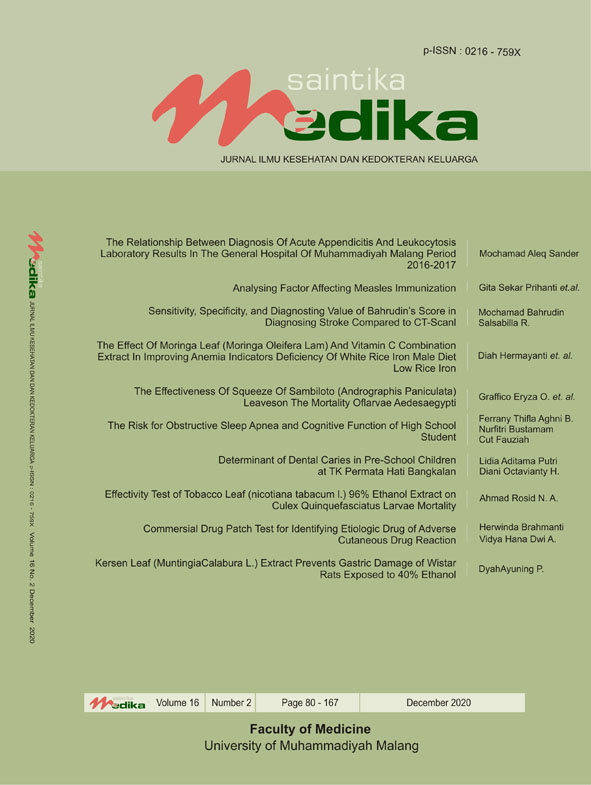Sensitivity, Specificity, and Diagnosting Value of Bahrudin’s Score in Diagnosing Stroke Compared to CT-Scan
DOI:
https://doi.org/10.22219/sm.Vol16.SMUMM2.15044Keywords:
Bahrudin’s Score, CT-Scan, Stroke, Diagnostic ToolAbstract
Stroke is an emergency situation leading to disability and death. Fast, precise, and easy diagnostic tools is needed as an substitute for CT-Scan, especially when CT-Scan is not available. This study is conducted to determined sensitivity, specificity, and diagnostic value of Bahrudin’s Score compared to CT-Scan in diagnosing bleeding or infarct stroke. This research was conducted at Gambiran Kediri Hospital and Lamongan Muhammadiyah Hospital using 89 patients as samples. It was analyzed to define sensitivity, specificity, positive predictive value, negative predictive value, positive likelihood ratio, negative likelihood ratio, accuracy, reciever operating characteristic curve, and area under curve in order to define diagnostic value of Bahrudin’s Score. Infarct stroke was found in 54%, 58% happened in male and 96,6% found in age over 40. Sensitivity of Bahrudin’s Score is 0.868, specificity 0.860, positive predictive value os 0.825, negative predictive value is 0.896, positive likelihood ratio is 6.600, negative likelihood ratio is 0.153, accuracy 0.864, and AUC 86.4%. It is determined that Bahrudin’s score with AUC 86.4% is feasible to replace CT-Scan when it is not available.
Downloads
References
American Heart Association (2017). Let’s Talk about Stroke : Risk factors for stroke. tersedia pada : www.strokeassociation.org/letstalkaboutstroke. (diakses 15 September 2019)
Bahrudin M, 2015, Bahrudin Skor (Skor diagnostic untuk menentukan jenis stroke perdarahan atau sumbatan berdasarkan gejala klinis), Cakrawala Indonesia, Malang. pp. 68 – 72.
Bahrudin M, 2017, Stroke dalam Neurologi Klinis, UMM Press, Malang, pp. 239 – 302.
Choudhury MJH, Chowdhury MTI, Nayeem A, & Jahan WA, 2015, Modifiable and Non-Modifiable Risk Factors of Stroke: A Review Update, Journal of National Institute of Neurosciences Bangladesh, 1(1), pp.22–26. https://doi.org/10.3329/jninb.v1i1.22944
Coupland AP, Thapar A, Qureshi MI, Jenkins H, Davies AH. The definition of stroke. J R Soc Med. 2017;110(1):9–12.
Dahlan Sopiyudin, 2009, Penelitian diagnostik, Salemba medika, Jakarta.
Feignin V. 2007, Stroke, Panduan Bergambar Tentang Pencegahan dan Pemulihan Stroke. Jakarta: PT Bhuana Ilmu Populer. Pp. 9-20
Japardi, Iskandar 2002, Patofisiologi Stroke Infark akibat tromboemboli, Available from URL: http://www.library.usu.ac.id diakses 20 Juli 2009
Kemenkes RI, 2013, Riset Kesehatan Dasar (RISKESDAS), Balitbang
Kemenkes RI, Jakarta.
Kemenkes RI, 2014, Infodatin : Situasi Kesehatan Jantung, Pusat Data dan Informasi Kementrian Kesehatan RI, Jakarta.
Kemenkes RI, 2018, Hasil Utama Riskesdas di Indonesia 2018, Balitbang Kemenkes RI, Jakarta.
Kusuma Y, Venketasubramanian N, Kiemas LS, Misbach J. Burden of stroke in Indonesia. Int J Stroke. 2009;4(5):379–80.
Masood CT, Hussain M, Anis-ur-Rehman, & Abbasi S, 2016, Clinical presentation, risk factors and outcome of stroke at a district level teaching hospital, Journal of Ayub Medical College,Abbottahad : JAMC, 25(1-2), pp. 49-51
Parmar P, 2018, Stroke : classification and diagnosis, The Pharmaceutical Journal, London North West University Healthcare NHS Trust, pp. 01 – 15 https://doi.org/10.1211/CP.2018.20204150
Sustrani, Alam, 2006, Stroke, Jakarta, Gramedia Pustaka Utama, pp 7 – 33 Trisetiawati
Downloads
Published
Issue
Section
License
Authors who publish with this journal agree to the following terms:
- Authors retain copyright and grant the journal right of first publication with the work simultaneously licensed under a Creative Commons Attribution-ShareAlike 4.0 International License that allows others to share the work with an acknowledgment of the work's authorship and initial publication in this journal.
- Authors are able to enter into separate, additional contractual arrangements for the non-exclusive distribution of the journal's published version of the work (e.g., post it to an institutional repository or publish it in a book), with an acknowledgment of its initial publication in this journal.
- Authors are permitted and encouraged to post their work online (e.g., in institutional repositories or on their website) prior to and during the submission process, as it can lead to productive exchanges, as well as earlier and greater citation of published work (See The Effect of Open Access).

This work is licensed under a Creative Commons Attribution-ShareAlike 4.0 International License.
















